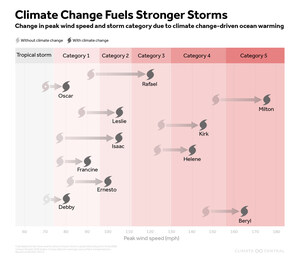Graphics illustrate potential impacts spurring climate scientists and policy experts to propose setting sea level rise limits to reduce coastal nations' land loss.
PRINCETON, N.J., Sept. 24, 2024 /PRNewswire/ -- Climate Central has released a new mapping resource showing the potential for climate change to alter nations' coastlines, illustrating the stakes highlighted by a group of experts calling for a sea level rise upper limit.
The group includes individual scientists and experts on United Nations climate negotiations from a range of organizations, such as the International Cryosphere Climate Initiative (ICCI), Woods Hole Oceanographic Institution (WHOI), the United Nations Foundation, the CLEO Institute, ReThink Energy Florida, and Climate Strategies. (Climate Central is not a member of the group, but has provided resources to visualize coastal impacts.) As the consequences of rising seas are addressed during this week's United Nations General Assembly, these experts caution that global commitments to reduce greenhouse gas emissions are insufficient to keep coastal nations from losing large amounts of land to the ocean in the coming decades. The group's proposal to identify a specific sea level target – an upper limit – is intended to better focus climate change negotiations on consequences for low-lying countries and cities, spurring more urgent climate action.
The proposal echoes recommendations in a report released yesterday by WHOI examining local and global impacts of sea levels projected to rise 15-29 centimeters by 2050, with a far wider potential range by 2100, depending on greenhouse gas emissions. Findings underscore low-lying coastal communities' uncertain futures as land and critical infrastructure falls beneath the tideline.
ICCI cites peer-reviewed studies projecting up to three meters of sea level rise by the early 2100s if carbon pollution continues unabated. Climate Central modeling estimates that more than 550 million people live today on land that would fall below the tideline if seas were to rise by a global average of three meters. Climate Central's mapping tools illustrate extensive changes to coastlines in that scenario, in some cases erasing large portions of coastal nations.
Alternatively, projections cited by ICCI estimate that deep and rapid emissions cuts could limit global sea level rise by the early 2100s to roughly one meter, on average. Compared to a three-meter rise, that reduction would protect land now home to 320 million from sinking beneath the tideline, according to Climate Central, whose risk maps illustrate a sharp difference.
"Since the signing of the Paris Agreement, our understanding of the risks from loss of cryosphere — especially the great ice sheets of Antarctica and Greenland — has grown, with potentially higher and faster sea-level rise, and at lower temperatures than believed in 2015," Pam Pearson, director at ICCI said.
Although neither the NDC pledges made during United Nations climate change negotiations, nor nations' progress toward those commitments are so far on track to meet temperatures targets established by the Paris Agreement, experts calling for a sea level rise upper limit support keeping all negotiated targets in place.
"The 1.5 degree Celsius temperature goal of the Paris Agreement was hard fought, and no one wishes to change it," Dr. Daniel Reifsnyder, adjunct professor, University of Virginia's Batten School of Leadership and Public Policy, and co-chair, Paris Agreement negotiations 2015, said. "But that goal alone has not yet produced the sense of urgency or the level of action needed. An additional metric that is easier for people to understand – like an upper limit to sea-level rise – might work to bring home the concern with global warming and spur additional efforts."
Reifsnyder co-authored a column in yesterday's Tampa Bay Times with Dr. Kilaparti Ramakrishna, director of the marine policy center and senior advisor to the president on ocean and climate policy at WHOI, explaining the potential for a sea level rise upper limit to focus discussions at the United Nations General Assembly on accelerating climate action to avoid the worst impacts of rising seas.
In addition to publicly available, interactive maps produced by its Coastal Risk Screening Tool, Climate Central has produced GIS-compatible files – available by request – to support the development and publication of localized maps showing the projected impact of one and three meters of sea level rise on nations' coastlines.
"These maps represent the potential for choices made today by governments and industries to alter the course of human history," Dr. Benjamin Strauss, CEO and chief scientist of Climate Central said. "Discussions in New York this week, at the U.N. General Assembly and elsewhere among scientists, policy experts and national representatives, will contribute to the long-term survival – or disappearance – of many cities and some entire nations."
To request a set of digital files, delivered as geoTIFFs, enabling localized, customizable reproduction of Climate Central's 1- and 3-meter sea level rise maps, please complete the request form at: https://bit.ly/Climate-Central-request-1-3m
About Climate Central
Climate Central is a non-advocacy, non-profit science and news organization providing authoritative information to help the public and policymakers make sound decisions about climate and energy.
SOURCE Climate Central

WANT YOUR COMPANY'S NEWS FEATURED ON PRNEWSWIRE.COM?
Newsrooms &
Influencers
Digital Media
Outlets
Journalists
Opted In





Share this article